
When it comes to pre-built desktop gaming PCs, Lenovo's Legion series offers a few gems, and they're perfect for anyone who isn't comfortable building their own rig. These start with the Legion Y520T ("T" for "tower") and end with the Legion Y920T, with the Y720T sitting in the middle. The latter two options are quite closely matched in build and hardware — and we have both here on loan — so an in-depth comparison seems only natural.
Is the Legion Y920T or the Legion Y720T the better option for you? Let's find out.
Lenovo Legion Y720T vs. Y920T: Hardware and specifications
| Category | Legion Y720T | Legion Y920T |
|---|---|---|
| Processor | Intel Core i5-7400 (3.00GHz)Intel Core i7-7700 (3.60GHz) | Intel Core i7-7700K (4.20GHz) |
| RAM | 8GB/16GB DDR4-2400MHz | 16GB DDR4-2400MHz |
| Storage | 1TB 7,200RPM HDD128GB/256GB PCIe SSD | 1TB 7,200RPM HDD128GB/256GB PCIe SSD |
| Graphics | AMD Radeon RX 570 4GBNVIDIA GTX 1050 Ti 4GBNVIDIA GTX 1060 6GBNVIDIA GTX 1070 8GB | NVIDIA GTX 1070 8GBNVIDIA GTX 1080 8GB |
| Motherboard | H270 chipset | Z270 chipset |
| Wireless | Intel Dual Band Wireless 8265802.11ac (2 x 2)Bluetooth 4.1 | Killer Wireless 1535802.11ac (2 x 2)Bluetooth 4.0 |
| Optical drive | DVD | DVD |
| Power supply | 450W | 625W |
| Dimensions | 18.85 in x 19.82 in x 8.12 in (478.9 mm x 503.5 mm x 206.4 mm) | 18.85 in x 19.82 in x 8.12 in (478.9 mm x 503.5 mm x 206.4 mm) |
| Weight | Starting at 31.08 pounds (14.1 kg) | Starting at 31.08 pounds (14.1 kg) |
| OS | Windows 10 Home | Windows 10 Home |
| Price | Starting at about $900 | Starting at about $1,600 |
Lenovo Legion Y720T vs. Y920T: Performance


Thanks to more powerful hardware options, including an overclockable Intel Core i7-7700K processor (CPU), 16GB of RAM, and an NVIDIA GTX 1080 graphics card (GPU), the Y920T we're testing pulls ahead of the Y720T, with its Intel Core i7-7700 CPU, 16GB of RAM, and NVIDIA GTX 1070 GPU.
To get an idea of the performance difference, we ran a few benchmark tests, including PCMark, 3DMark, and VRMark.
PCMark Home Conventional 3.0
| Device | Score | Comparison |
|---|---|---|
| Legion Y720T | 3,373 | Better than 66 percent of all results |
| Legion Y920T | 4,682 | Better than 97 percent of all results |
3DMark Fire Strike
| Device | Score | Comparison |
|---|---|---|
| Legion Y720T | 13,172 | Better than 79 percent of all results |
| Legion Y920T | 16,996 | Better than 91 percent of all results |
VRMark Orange Room
| Device | Score | Comparison |
|---|---|---|
| Legion Y720T | 9,028 | Better than 78 percent of all results |
| Legion Y920T | 10,173 | Better than 89 percent of all results |
One of the major things the Y920T has going for it — other than overclocking ability — is Oculus-Ready certification. This means that, in theory, you should be able to install software, plug in the Rift, and be ready to go in VR. This also means you'll be able to access Oculus support if things aren't running correctly. In our experience, both the Y720T and Y920T worked very well in VR, despite the Y720T not having the same Oculus-Ready certification.
Lenovo Legion Y720T vs. Y920T: Chassis
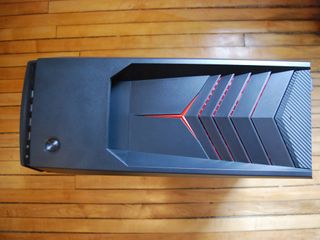
Gaming PCs are usually built to draw attention, and both the Legion Y720T and Y920T do a good job of offering up something that isn't overdone or garish. While both towers have the same dimensions and share pretty much the same design at first glance, there are some subtle differences in appearance.
Get the Windows Central Newsletter
All the latest news, reviews, and guides for Windows and Xbox diehards.
Both have a carbon-fiber finish on the front and have a bit of Lenovo branding, and both have LED lighting. However, only the Y920T's lighting comes with customizable options like color and pulse. There's also lighting on the Y920T's rear fan and, thanks to a window on the side, it is visible at all times. The Y720T does not have the same inner lighting, and there is no window on the side panel.
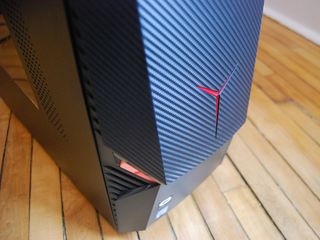
Access to internal hardware is the same on both PCs. You slide a switch, push down on a large release button, and the side panel pulls away. Both also feature tool-free tinkering, so you can easily upgrade and change the layout. There's plenty of room for upgrades, and cable management from the factory is evident.
Neither tower can be considered light at about 31 pounds, but a built-in handle on the top makes it easy to move around when changing rooms or reconfiguring your layout for a VR setup. The optical drive in each is hidden behind a carbon-fiber plate, and there's an extra bay in case you want to upgrade.




Not only is the amount of ports important on gaming machines, it's also all about the placement. Both PCs have a ton of options, both on the back and front, making it easy to connect a VR headset, keyboard, mouse, headset, monitor, and any other peripherals you have lying around.
Here's a breakdown of what each PC has for ports. Keep in mind some might change depending on which GPU you decide to go with.
| PC | Ports (front) | Ports (rear) |
|---|---|---|
| Legion Y720T | Two USB-A 3.0Two USB-A 2.0USB-CSD card reader3.5mm microphone jack3.5mm headphone jack | Two USB-A 3.0Four USB-A 2.0EthernetVGAPS/2Six audio portsDVIHDMI 2.0Three DisplayPort 1.4 |
| Legion Y920T | Four USB-A 3.1USB-CHDMI3.5mm headset jack | Four USB-A 3.0Two USB 2.0PS/2VGASix audio portsEthernetDVIHDMI 2.0Three DisplayPort 1.4 (one routed to front HDMI) |
For those interested in multimedia editing, the SD card reader on the Y720T might be attractive, while those looking for a VR machine will likely want to opt for the HDMI port on the front on the Y920T.
Lenovo Legion Y720T vs. Y920T: Keyboard and mouse
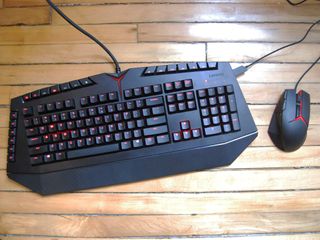
Both of these PCs come with an included keyboard and mouse combo, but they're quite a bit different despite both being gaming PCs. The Y920T comes with Lenovo's Gaming Precision mouse and Gaming Mechanical keyboard. The keyboard has plenty of extra buttons for "hotkeying" and quick control, and it also has a red backlight. On the side, there's a USB-A port and a mic and headphone jack, making it easy to hook up your peripherals.
The mouse has a few customizable buttons on the side, and an included package contains four small weights that can be added through an access panel in the bottom of the mouse.
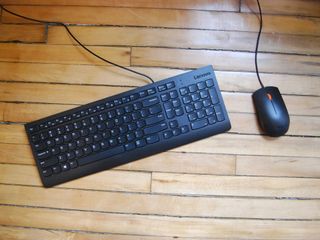
The Y720T comes with a standard mouse and keyboard without any extra features. They work well enough for productivity reasons but will likely feel quite lacking for any gamers used to the extra buttons and feel of a mechanical keyboard.
Lenovo Legion Y720T vs. Y920T: Conclusion
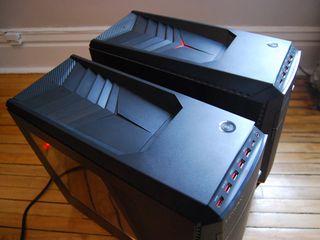
Choosing between these two PCs really comes down to budget and what you're looking to use it for. The Y920T we tested is considerably more expensive (about $2,500) than the Y720T we tested (about $1,850), but in the former, you get that big GTX 1080 GPU and the overclockable Core i7-7700K CPU. For maximum performance and for something that has the Oculus-Ready certification, take a closer look at the Y920T.
On the other hand, the Y720T performed very well in comparison, and although it doesn't have the same Oculus certification, it ran Vive, Rift, and Windows Mixed Reality with ease. If it's a gaming machine you're looking for and want to save a considerable chunk of change, the Y720T is available in far more configurations and is undoubtedly a fine machine.
More resources
Be sure to check out our guides for other great pre-built desktops PCs.

Cale Hunt brings to Windows Central more than eight years of experience writing about laptops, PCs, accessories, games, and beyond. If it runs Windows or in some way complements the hardware, there’s a good chance he knows about it, has written about it, or is already busy testing it.